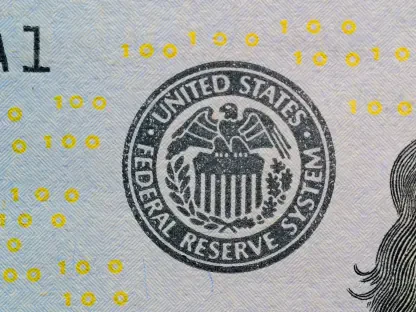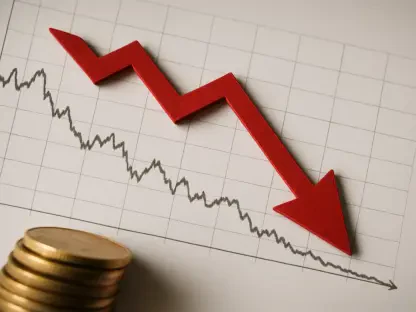The recent surge in the US dollar (USD) has sparked intense debate among forex traders and market analysts, who are closely monitoring whether this upward momentum can withstand mounting pressures. Strong economic indicators, including a revised second-quarter GDP growth of 3.8%, a decline in initial jobless claims to 218,000, and a surprising 2.9% increase in durable goods orders for August, have fueled a hawkish outlook on Federal Reserve (Fed) rate expectations. This has propelled the dollar to new heights, reflected in rising short-dated USD swap rates. Yet, beneath this apparent strength, cracks are beginning to show. Upcoming data releases and global uncertainties could quickly reverse the trend, leaving many to question the sustainability of this rally. As the forex market braces for critical developments, the interplay of economic signals, central bank policies, and geopolitical risks paints a complex picture of what lies ahead for the USD and its counterparts.
US Dollar Strength: A Temporary Surge?
Drivers Behind the Rally
The foundation of the USD’s recent strength lies in a series of robust economic data points that have caught the market’s attention. A revised GDP growth figure of 3.8% for the second quarter signaled a resilient US economy, surpassing earlier expectations and reinforcing confidence in sustained growth. Alongside this, initial jobless claims dropped to a remarkable 218,000, indicating a tight labor market, while durable goods orders for August rose by an unexpected 2.9%. These figures have collectively driven a hawkish repricing of Fed rate expectations, with markets anticipating a more aggressive stance on monetary tightening. Short-dated USD swap rates have climbed in response, providing a tailwind for the dollar’s rally. However, while these numbers paint a rosy picture, they also raise questions about whether the market has overreacted, potentially setting the stage for a correction if future data fails to meet such high benchmarks.
Beyond the raw data, market sentiment has played a significant role in amplifying the USD’s ascent. Investors have shown a renewed appetite for the dollar as a safe haven amid global uncertainties, even if geopolitical tensions haven’t directly fueled this rally. The hawkish tilt in Fed expectations has squeezed USD bears, forcing positioning adjustments that further bolster the currency’s value. Yet, skepticism remains among analysts who argue that the rally appears overextended when measured against fundamental economic models. The risk of disappointment looms large, especially if upcoming indicators suggest a slowdown or if the Fed signals a more cautious approach to rate hikes. This delicate balance between strong data and heightened expectations underscores the fragile nature of the current surge, hinting that the dollar’s strength might be more fleeting than it appears at first glance.
Potential Catalysts for a Reversal
Attention is now turning to key upcoming data releases that could serve as turning points for the USD’s trajectory. The August core Personal Consumption Expenditures (PCE) index, expected to show a modest 0.2% month-on-month increase, stands out as a critical indicator. A benign reading could ease market expectations for aggressive Fed tightening in December, potentially recalibrating forecasts for rate cuts to around 40-45 basis points. Such a shift might drag the dollar below significant thresholds, like a DXY index level of 98.0, signaling the start of a broader pullback. This data point, often seen as the Fed’s preferred measure of inflation, carries substantial weight in shaping monetary policy outlooks, making it a focal point for traders seeking clues about the dollar’s near-term direction.
Moreover, the broader context of market dynamics adds layers of complexity to this potential reversal. Even as recent economic strength has supported the USD, the risk of softer data in the coming weeks—such as payroll figures—could further undermine confidence in sustained growth. Analysts note that the current rally has been driven partly by positioning adjustments, where USD bears have faced pressure from unexpectedly strong figures. However, if the core PCE or subsequent releases fall short of expectations, the momentum could quickly shift, allowing for a correction. This vulnerability highlights the importance of monitoring not just the data itself, but also how markets interpret and react to it, as sentiment can often amplify or mute the impact of economic indicators on the dollar’s value.
Global Currency Impacts and Risks
Euro and Yen in the Spotlight
The implications of the USD’s rebound ripple across major currencies, with the Euro (EUR) and Japanese Yen (JPY) facing unique challenges and opportunities. For the EUR, a narrowing rate differential with the USD offers a glimmer of hope for a recovery above the 1.170 mark. Despite a recent 15-basis-point widening in favor of the dollar, the EUR’s short-term fair value is estimated around 1.180, suggesting room for upward movement if US data softens. Eurozone inflation expectations and local economic indicators will play a crucial role in determining whether this potential rebound materializes. However, external pressures, including geopolitical risks in Europe, could dampen optimism, keeping traders cautious about placing overly bullish bets on the EUR in the near term.
Meanwhile, the JPY finds itself grappling with domestic headwinds that compound the challenges posed by a strong USD. Softer-than-expected Tokyo CPI data has curbed market expectations for a Bank of Japan (BoJ) rate hike in the coming months, weakening the yen’s position. Excursions above 150.0 in USD/JPY have been notable, yet analysts view these levels as unsustainable in the long run. A pullback in USD strength could provide much-needed relief for the JPY, allowing it to regain some ground. This dynamic reflects a delicate balance between local policy constraints and global currency trends, with the yen’s outlook hinging on both domestic inflation developments and the broader trajectory of the dollar in the forex market.
Geopolitical Uncertainties
Geopolitical tensions introduce an unpredictable element into the currency markets, with the potential to disrupt the USD’s current path indirectly. While the dollar’s recent strength doesn’t appear to be driven by global unrest, escalating issues in Europe—such as NATO’s heightened readiness to intercept Russian planes violating airspace—could shift market sentiment. Such developments often weigh on risk-sensitive currencies like the EUR, creating a ripple effect that might influence broader forex dynamics. If tensions intensify, investors could flock to safe-haven assets, potentially bolstering the USD further in the short term, even if economic fundamentals suggest a looming correction.
The broader impact of these geopolitical risks extends beyond immediate market reactions, shaping longer-term sentiment in unexpected ways. Currency markets are notoriously sensitive to sudden shifts in global stability, and any escalation could unnerve investors, prompting a reevaluation of risk exposure. For the USD, this could mean a temporary boost as a safe haven, but it also risks overshadowing economic data that might otherwise signal a reversal. The challenge for traders lies in distinguishing between transient geopolitical noise and genuine shifts in market fundamentals, a task made harder by the complex interplay of regional tensions and their indirect effects on currency valuations worldwide.
Regional Dynamics in Central and Eastern Europe
Local Pressures Amid Global Trends
In Central and Eastern Europe (CEE), local currencies are navigating a challenging landscape shaped by both a strong USD and persistent domestic inflationary pressures. Central banks in countries like Hungary, the Czech Republic, and Poland are grappling with rising wage growth and price pressures, which threaten to undermine currency stability. The Hungarian Forint (HUF), for instance, faces risks from heavily positioned long trades if global USD strength persists. While regional FX markets have shown relative resilience so far, the overarching pressure from a robust dollar adds a layer of vulnerability, prompting cautious rhetoric from policymakers focused on balancing growth and inflation control.
Beyond immediate currency concerns, the CEE region’s economic outlook is closely tied to broader global trends that amplify local challenges. Central banks are adopting a wait-and-see approach, wary of tightening too aggressively amid fears of stunting growth, yet conscious of the need to curb inflation. This delicate balancing act is complicated by external factors, such as potential shifts in USD momentum or disruptions in global trade due to geopolitical unrest. For now, stability prevails in CEE forex markets, but the dual pressures of domestic economic conditions and international currency dynamics suggest that any sustained USD rally could tip the scales, exposing regional currencies to heightened volatility.
Path Ahead for Regional Stability
Reflecting on the past, the journey of CEE currencies through recent global pressures revealed a surprising degree of resilience, even as the USD mounted a formidable rally. Central banks in the region maintained a steady hand, prioritizing measured responses to inflation over knee-jerk reactions to external currency strength. Their cautious stance helped mitigate sharp declines in local currencies, preserving a semblance of stability despite challenging conditions. The focus on domestic economic fundamentals, rather than purely reactive policies, underscored a pragmatic approach to navigating the turbulent forex landscape that characterized much of the recent period.
Looking forward, the path to sustained stability in CEE hinges on proactive measures and close monitoring of both local and global developments. Central banks should continue refining their strategies to address inflationary pressures without compromising growth, potentially through targeted interventions or nuanced rate adjustments. At the same time, staying attuned to shifts in USD momentum and geopolitical events will be crucial for preempting volatility. By fostering dialogue with international financial bodies and maintaining flexible policy frameworks, the region can better position itself to weather future uncertainties, ensuring that local currencies remain insulated from the broader ebbs and flows of the forex market.









